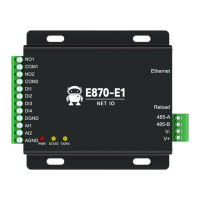
Do you have a question about the Ebyte E870-E1 and is the answer not in the manual?
E870-E1 is an Ethernet cloud IO gateway based on the Ebyte Cloud Device Communication Protocol.
Lists the key features and capabilities of the E870-E1 gateway, including protocols and I/O.
Outlines the necessary hardware components and network environment for initial device setup.
Details the steps to connect the E870-E1 gateway to the Ebyte cloud platform.
Step-by-step guide to connecting the device to the Ebyte cloud platform via the web interface.
Instructions for connecting the device to a user-created server using host computer configuration.
Schematic diagram illustrating how to connect analog input signals to the device.
Schematic diagram showing the connection of digital input (switch) signals to the device.
Schematic diagram for connecting external loads to the device's relay output channels.
Comprehensive technical specifications of the E870-E1 gateway, covering electrical, physical, and communication parameters.
Visual representation of the device's physical dimensions, mounting holes, and port layout.
Detailed explanation and pinout for all physical ports available on the E870-E1 gateway.
Explains the status indicated by the PWR, STATE, and DATA LEDs on the device.
Details the configurable parameters for the device's serial port communication, such as baud rate and data bits.
Describes the functionality and configuration of the Digital Output (DO) relay channels for controlling external devices.
Explains the functionality and active reporting capabilities of the Digital Input (DI) channels for monitoring signals.
Details the configuration and operation of the Analog Input (AI) channels for current signal acquisition.
Enables seamless data transfer between serial devices and network servers without data conversion.
Provides instructions for configuring the device to connect and communicate using the MQTT protocol.
Steps to connect the E870-E1 to Alibaba Cloud using its specific platform parameters.
Steps to connect the E870-E1 to Baidu Cloud using its specific platform parameters.
Steps to connect the E870-E1 to the OneNET platform using its specific cloud parameters.
Guide for connecting to a standard MQTT server, exemplified by Tencent's service.
Converts serial Modbus RTU data into Ebyte Cloud's JSON message format for transmission.
Converts serial Modbus RTU data into Alibaba Cloud's JSON message format for data exchange.
Collects external data points and reports them in JSON format, supporting real-time updates.
Allows the device to send registration packets to the server for identification and authorization.
Enables the device to send heartbeat packets to maintain an active connection with the server.
Overview of methods for upgrading the device's firmware, including network and serial port options.
Step-by-step instructions for performing firmware upgrades over the network connection.
Step-by-step instructions for performing firmware upgrades using the serial port connection.
Procedure to reset the device to its original factory default parameters and settings.
Describes how to use the device as an RTU slave, responding to Modbus RTU commands from a master device.